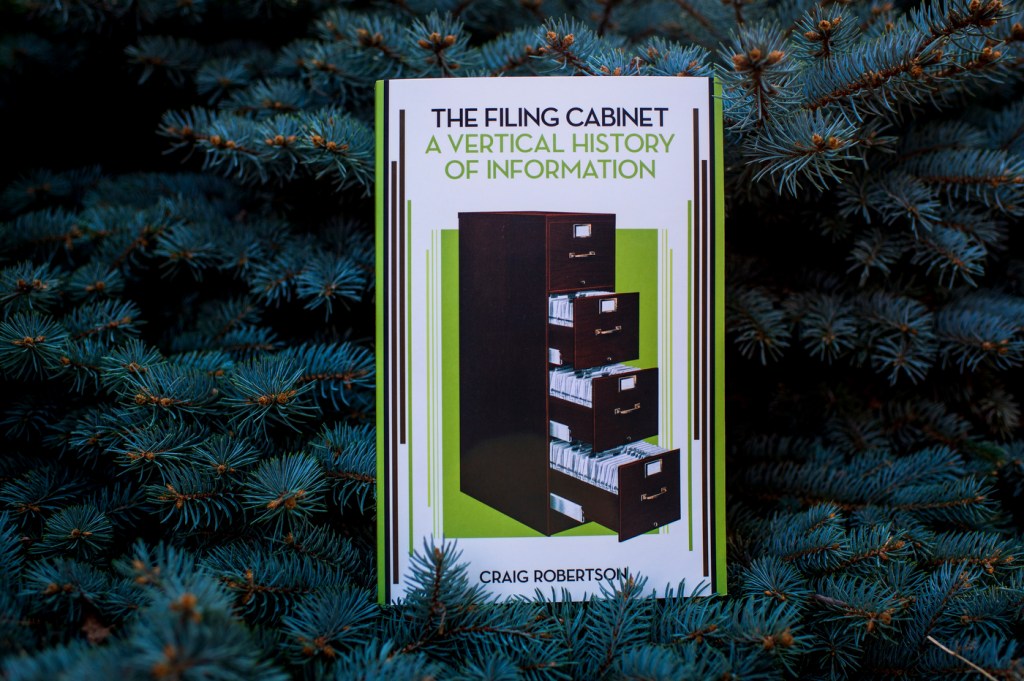The Surprising History of the Lowly Filing Cabinet

Craig Robertson’s latest book explores the untold story of a device that liberated American capitalism and continues to drive new technologies a century later.
His subject? The filing cabinet.
Its emergence in 1891 transformed business practices throughout the United States, says Robertson, an associate professor of communication studies, who spent close to a decade researching and writing “The Filing Cabinet: A Vertical History of Information.”
Robertson credits the filing cabinet with providing greater access to information as well as a narrow opening for women to enter the professional workplace.
Among the contributors to its invention was Melvil Dewey, who 15 years earlier had created the Dewey Decimal System that revolutionized the organization of libraries. Filing cabinets freed business managers from the cumbersome inefficiency of having to pore through ledger books for information.
It was while researching his previous book, “The Passport in America: The History of a Document,” that Robertson developed an interest in how businesses and bureaucracies developed the modern-day approach to organizing information. People around the world owe their dependence on computerized files and folders to the transformational breakthrough of filing cabinets.
“It’s a quirky book,” says Robertson. “It made me incredibly aware of how we store information—and of how we think about what information is.”

Robertson spoke with News@Northeastern about the culture of efficiency that was spawned by filing cabinets. His comments have been edited for brevity and clarity.
Why were filing cabinets invented?
In that period of 1890 to 1920, really significant change is happening in the U.S. as the country and the economy are getting bigger and bigger. The filing cabinet is a product of that time of modernization and efficiency in the offices of corporations, which themselves were an invention of this period.
The filing cabinet arrives because there is a perceived need to have more information and easier access to that information if you want to be productive and efficient in business.
How quickly did filing cabinets catch on?
By 1920, a filing cabinet is in every office, and not just business offices—it’s in professors’ offices, offices of clergy, offices of charities, offices of newspapers. It becomes the way to organize information.
Why did they make such a difference?
What made the filing cabinets so innovative is that they allowed loose paper to be stored vertically. It enabled you to remove paper from bound books so you could find things more easily.
You put all the different bits of loose paper in one folder with the customer’s name on it. And then, because it’s in a manila folder with a tab, you can get at it straight away.
This is the period when the phrase “information at your fingertips” starts to be used more frequently—in relation to the filing cabinet.
You argue that it spawned a new way of thinking about information?
To us now it’s a boring, bland bit of furniture or office equipment. But what makes it so important in the history of information technologies is that it helped popularize and encourage a way to think about information as something that you can move and circulate around the room.
How did the filing cabinet influence the role of women in professional settings?
In the office management literature of that time, they are really explicit about the idea that the man does the thinking, and the woman does the work that helps the man do the thinking.
The idea of the filing cabinet is that the female file clerk goes and picks out the relevant file—she doesn’t really have to think about it, because the filing cabinet has done that [organizing]—and she gives the file to the executive, the manager, the salesman, and then he weaves his magic and he does all the thinking and makes profit from it.
The reason women are targeted is because of a dominant cultural idea at that time that women have nimble fingers. That’s what got them into the textile factories, and it gets them into the office. You can see in interviews or articles with office managers, when they were interviewing a woman to be a file clerk, they bluntly asked her, ‘Do you crochet? Do you play the piano?’ They were interested in the natural physical dexterity that women were thought to have.
What became of filing cabinets? Why have they disappeared?
The death knell was the move to digital, away from paper. It’s funny, because in the first 30 to 40 years of the filing cabinet, it is a symbol of efficiency. But by the 1990s, it has become a symbol of inefficiency, of too much paper and information overload.
One of the reasons I think it’s worth writing a history of the filing cabinet is that even though the object itself has disappeared, all of its accoutrements continue to shape our encounter with information. We’re asked to think about files on our computer, and we put them in folders—the icon is a manila folder. We talk about a desktop, and we have a wastepaper basket, which people jokingly refer to as the round filing cabinet. We manage online content with browser tabs.
You can even see it with Siri and the gendered labor of the voices of women as these virtual assistants to help find information. They’re all legacies of the filing cabinet.
Did you happen to use a filing cabinet as you worked on this book?
I didn’t.
As I look around my office, I actually don’t have a filing cabinet. So maybe the book is some kind of therapy in dealing with the absence of a filing cabinet in my life.
For media inquiries, please contact media@northeastern.edu.






